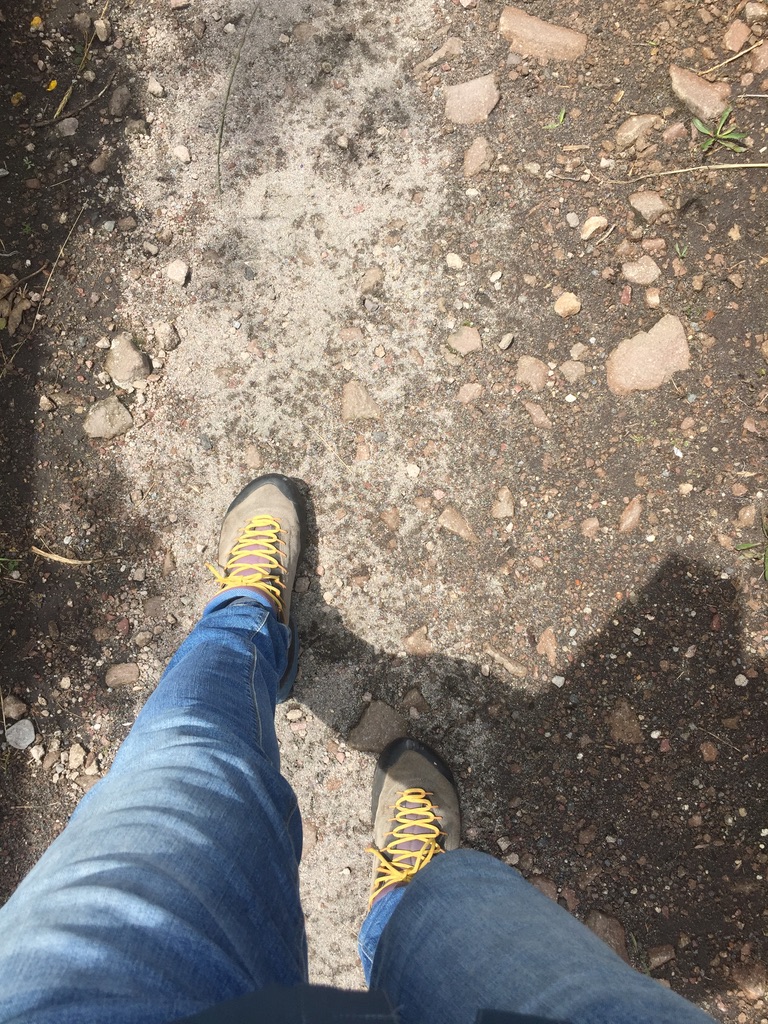For many people who come to Ecuador, one of the many highlights this beautiful Andean country has to offer is a visit to the Cuicocha crater lake.
As I stated in the Short introduction to my beautiful homecountry, Ecuador is mostly known for its spectacular diversity.
Besides dozens of volcanoes to climb – like the Fuya Fuya, above the Andean market town of Otavalo – you’ll find several spectacular crater lakes to explore.
One of the most astounding ones to visit is the Cuicocha crater lake. Located near Cotacachi, in the province of Imbabura, Ecuador. In its actual form, the Cuicocha lake was formed only recently – well, that is, just over three thousand years ago!
The lake lies in a crater beneath Mount Cotacachi (4944m/ 16220ft) – the tenth highest mountain of Ecuador. Besides rainfall, it’s the snow of Mount Cotacachi that feeds the Cuicocha lake.
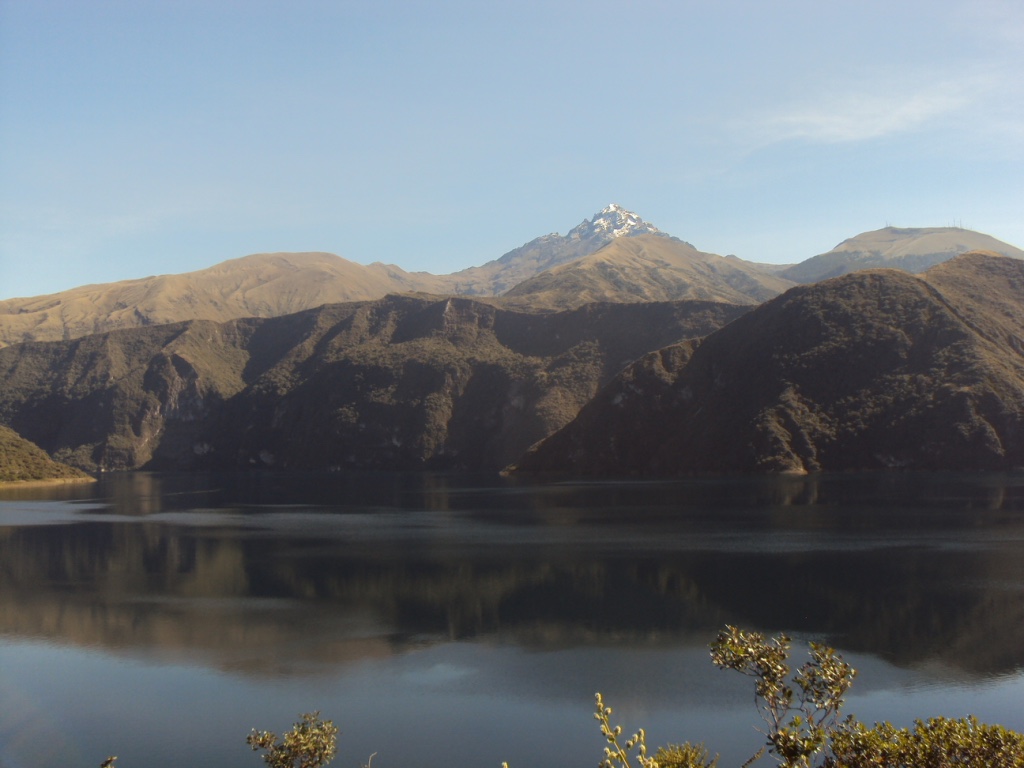
Background info on your visit to Cuicocha
Before I provide you with some Useful tips & recommendations on your visit to Cuicocha, I would like to give you some background information about the lake. Information that gives you a fair idea of where you’re heading for & around.
Where does the name Cuicocha come from?
Most people that visit the lake are told Cuicocha means the Lago del Cuy, the Lake of the Guinea Pig.
- Note: Cui or Cuy is Quichua for Guinea Pig, which the indigenous people consider a delicacy. Cocha stands for Lake.
The name was supposedly derived from the fact that one of the two islands that adorn the lake – the bigger one – looks like the back of a guinea pig. That is to say, for those who suffer from bad eyesight.
So, a rather dubious explanation, but … you never know, it may be true. However, other sources tell us Cuicocha actually means the Lago del Arco Iris, the Lake of the Rainbow. Others think it stands for the Lago de Dioses, the Lake of the Gods.
What’s certain though is that the indigenous people still visit and honour the lake regularly. Periodically they organise rituals there, like bringing offerings or taking ritual baths.
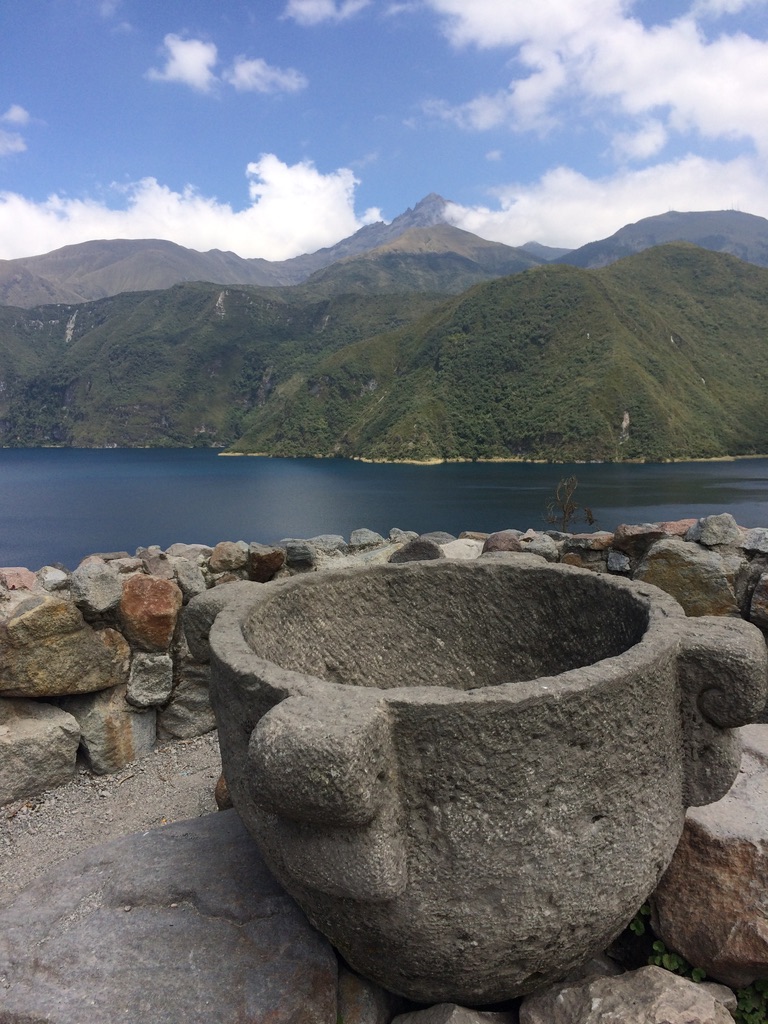
Two islands, not one
Characteristically are the two islands in the middle of the lake.
From certain angles it may look like there’s only one island, but there are actually two.
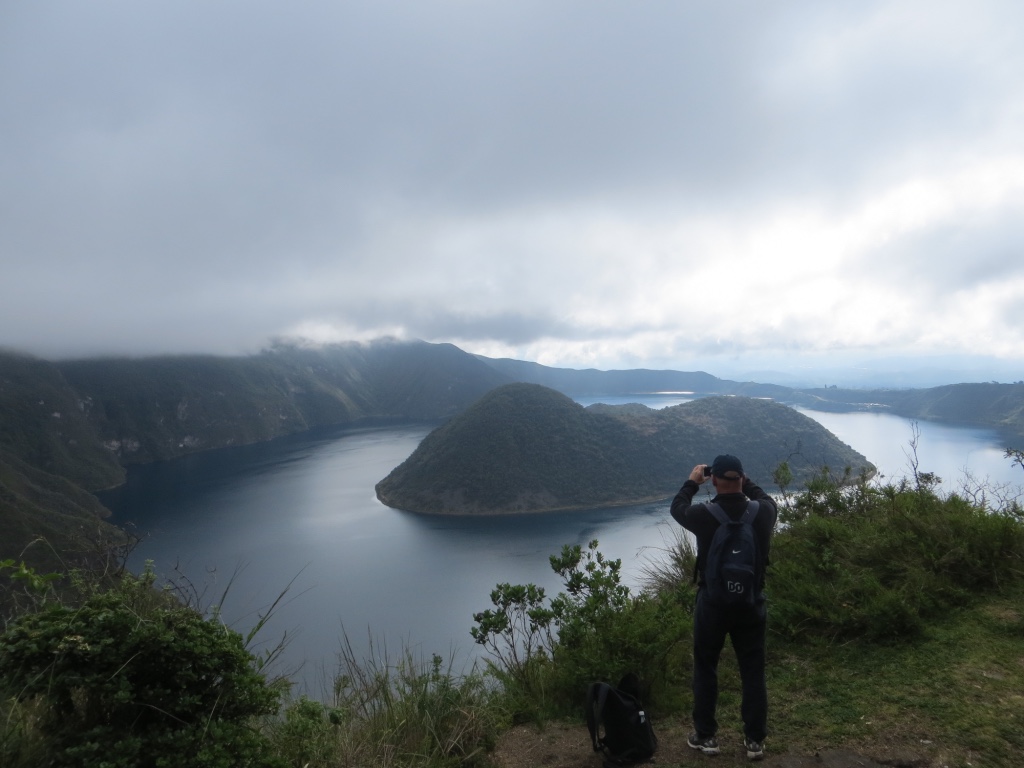
The bigger one is named after a German scientist, the geologist & botanist Teodoro Wolf (1841-1924).
- Note: Wolf realized important scientific work all over Ecuador. That’s why, besides the island, one of the Galápagos Islands was named after him. As well as a volcano.)
The name of the smaller island is Yerovi. Named after the Ecuadorian priest & later bishop José María de Jesús Yerovi (1819-1867). As a young man he visited Cuicocha with some friends, but almost lost his life after their boat had capsized. The little island was their last refuge, and because of that was named after him.
The islands were formed after the last eruptions. They behave like two corks or a split cork tapping the opening of the lake to the earth’s center.
From the shore or from the lake, they provide us with spectacular views. I twice had the honor to see the two islands from above. Once from an airplane, bringing me back to Ecuador. The second time, when I was standing on the Fuya Fuya volcano on a clear day. A unique sight.
National park & Geopark
What many visitors don’t know is that Cuicocha is just a tiny part of one of the biggest national parks of Ecuador. The Cotacachi-Cayapas Ecological Reserve, inaugurated in 1968. An area of 243 638 hectares (about 941 square miles), which stretches all the way to the Ecuadorian coast.
To get an idea of the whole area, there’s a beautiful scale model in the local museum at the lake.
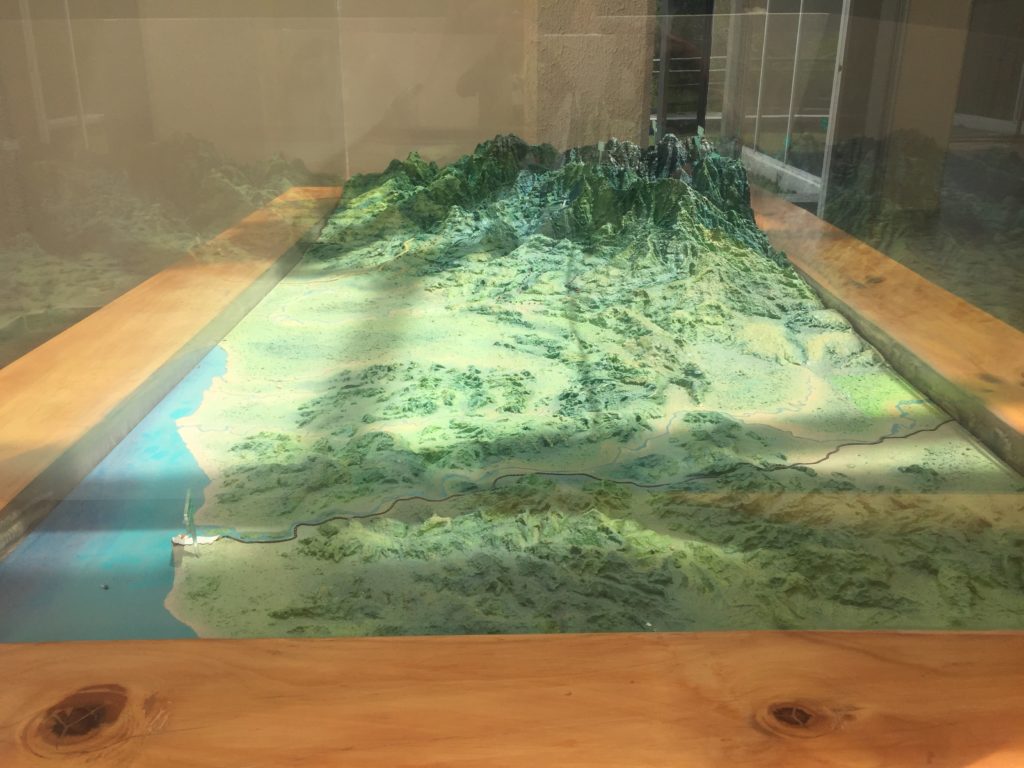
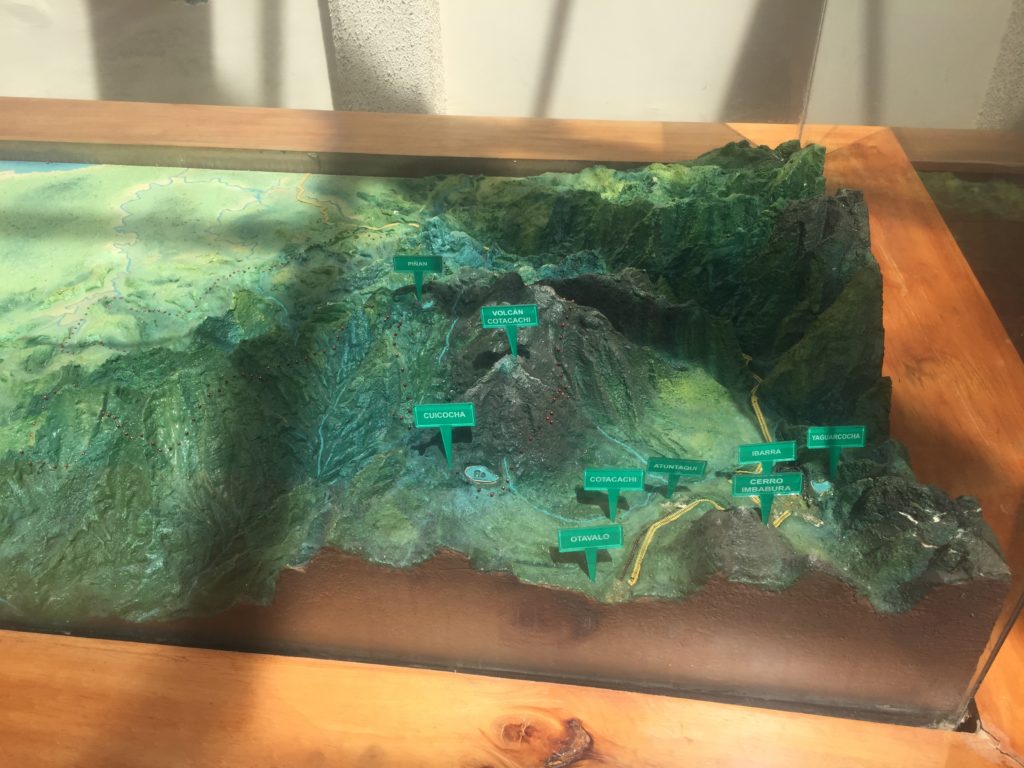
Besides being a national park, the whole province of Imbabura recently was declared a Geopark by the Unesco. It deserved that distinction mainly because of its many Natural Attractions. Like, for example, 28 bigger lakes.
Besides Cuicocha, the best known lakes are San Pablo, Yahuarcocha, and the Mojanda lake area. The last area houses three bigger lakes, as well as the Fuya Fuya volcano.
The unique Flora & Fauna of Cuicocha
When you visit the Cuicocha crater lake, you find yourself in a unique natural habitat – almost like visiting a small biosphere. That’s because you are inside a crater. It’s as if you are walking on the outer rim of a deep plate… a deep plate of soup, if you will. With views all around – open to the south & east, blocked by Mt. Cotacachi and its flanks in the northern & western direction.
You can spot plants, flowers, birds (different kinds of hummingbirds), little animals, and insects that are unique to this particular lake. In other words, flowers, plants and animals you won’t see in other areas of the country, or even… nowhere else in the world!
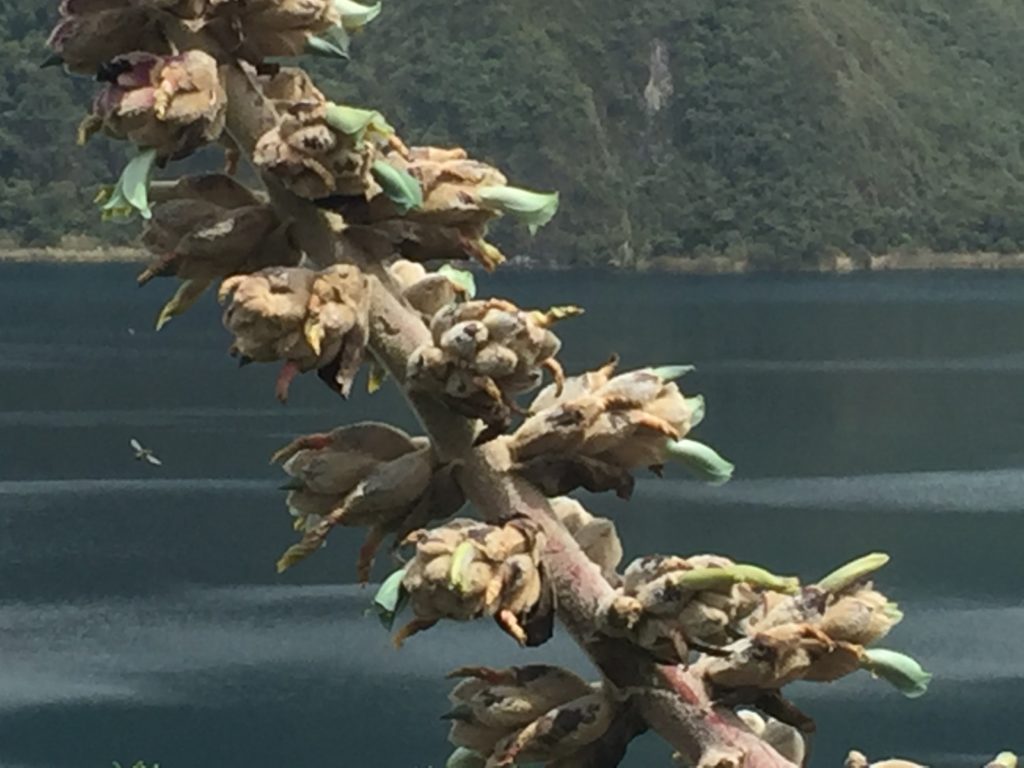
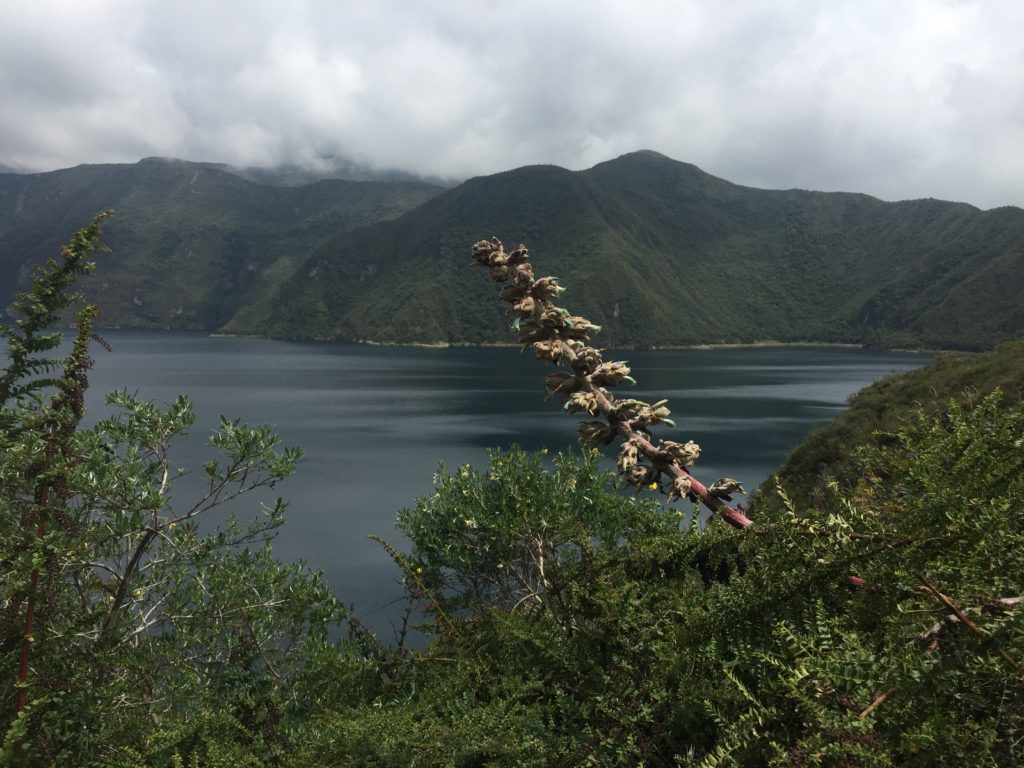
And if you’re lucky …
Some people have even spotted the Oso Andino/ Andean bear on the northern side of the lake (the side of the Mt. Cotacachi).
- Note: The Andean bear is also known as the Oso de Anteojos/The Spectacled bear.
Honestly, you have to be lucky to see one, but it’s certainly true that the bears live in the area. And because of the fact that the government nowadays is trying to protect them, the chances are getting bigger & bigger to spot one or two. Here, during your visit to Cuicocha, or elsewhere.
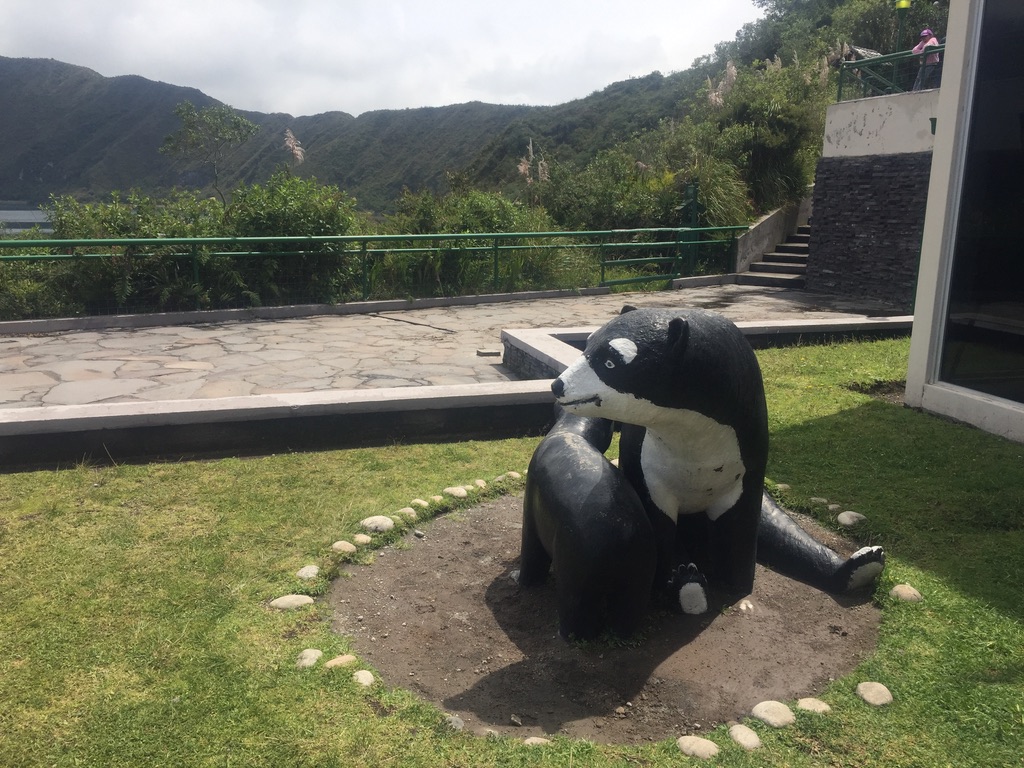
One of the places in Ecuador where you certainly can spot them is in Pimampiro. In the northern canton of the Imbabura province there’s a project protecting a group of bears living in one of their valleys. The project is called the Mirador del Oso Andino.
Until now I haven’t got the honor myself to spot a bear in the Cuicocha lake area. However, there are more & more people who told me of hearing or spotting one.
Go for a hike during your visit to Cuicocha
The starting point
Cuicocha is one of the easiest lakes to visit, because a road leads right into the crater. Taxis and pickups can leave you right at the Centro de Vistantes/ Visitors center. The starting point for your hike around the lake.
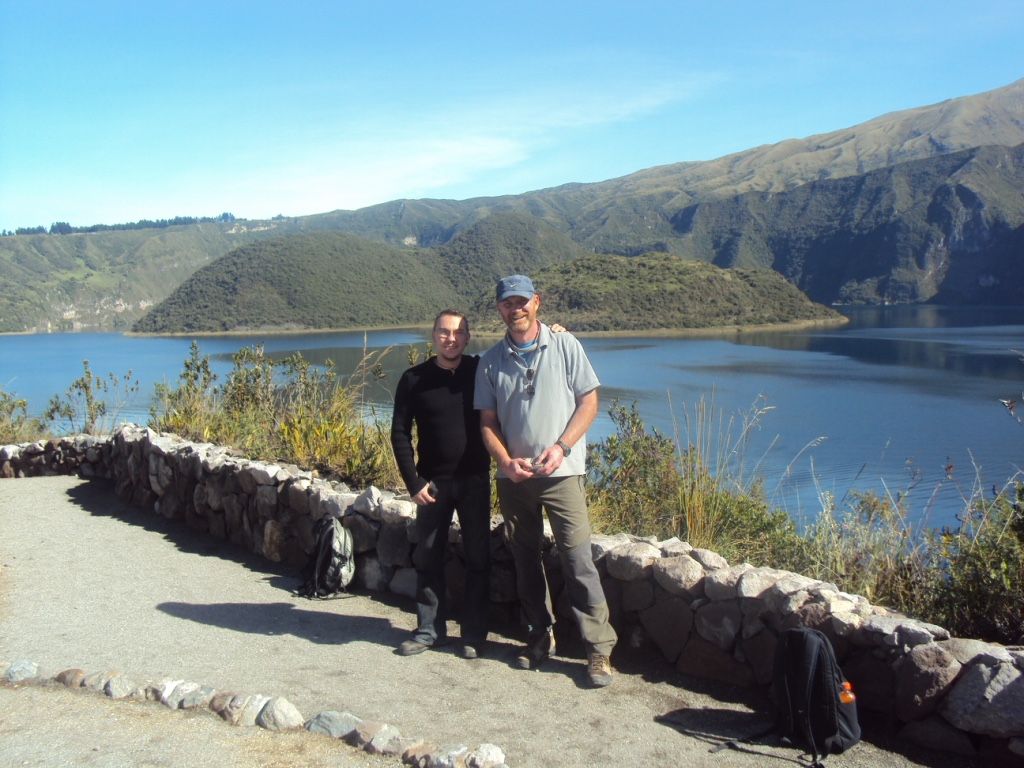
You can make the whole round or choose one of many alternative shorter routes. In other words, it is NOT necessary to circle the whole lake to get a good impression of the area & its unique flora & fauna.
After getting through the main entrance you’ll find the Visitors center on your right hand side. As you probably will arrive in a taxi or a pickup, ask the driver to drop you off there.
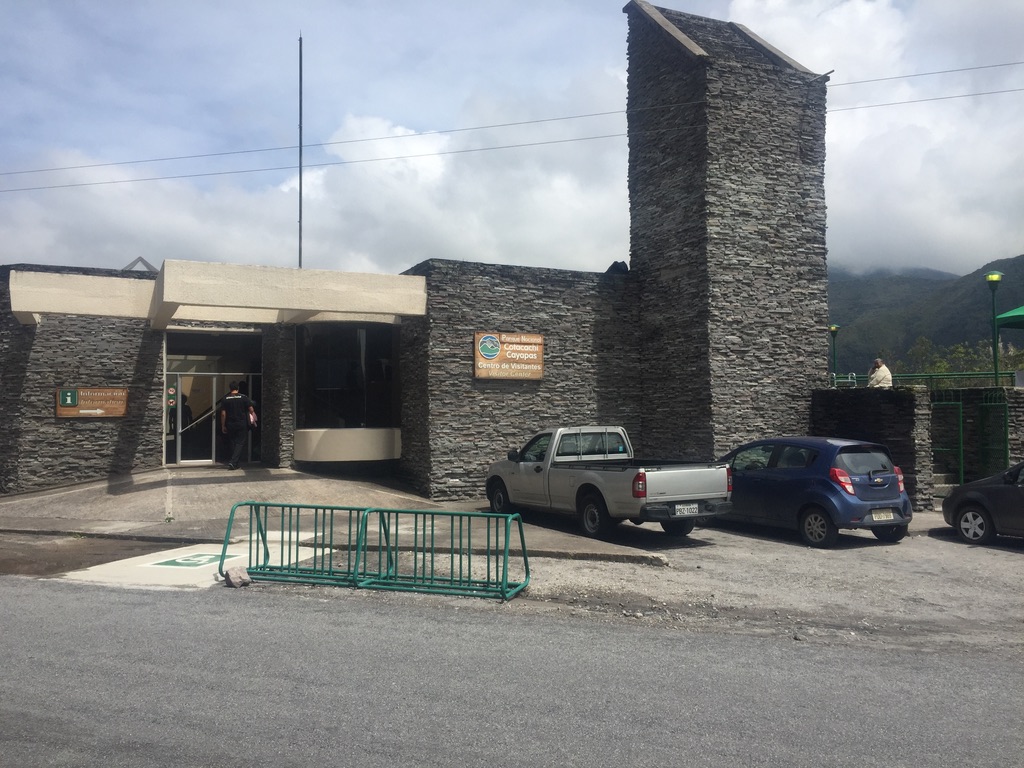
Clockwise or counterclockwise?
A few years ago the authorities tried to force every visitor to round the lake counterclockwise. I don’t know why really…? Maybe somebody at one of the ministries suffered from an Ecuadorian style Himalaya-syndrome.
- Note & Funny story! At the same time, it was prohibited to visit the lake on a bike. What a joke! I once got there myself on my bike, climbing up from about 2400m (7900 ft) to 3100m (10200 ft). More dead than alive, purple instead of just a deep sweaty red. And then, BIG SURPRISE .. They stopped me at the gate! At least that was what the Park ranger thought he was doing… I passed him without a word, had a short break at the lake, before my “flight” back home. Not after protesting at the entrance about the stupid rule of letting car & bus drivers in, while bikers weren’t!)
Back to your plan to hike around the lake: the rules changed again. So you can make the round counterclockwise or clockwise. Whatever you wish! You can do this, despite the fact that there still remain some signs – or maybe even some blogs or guidebooks – indicating otherwise.
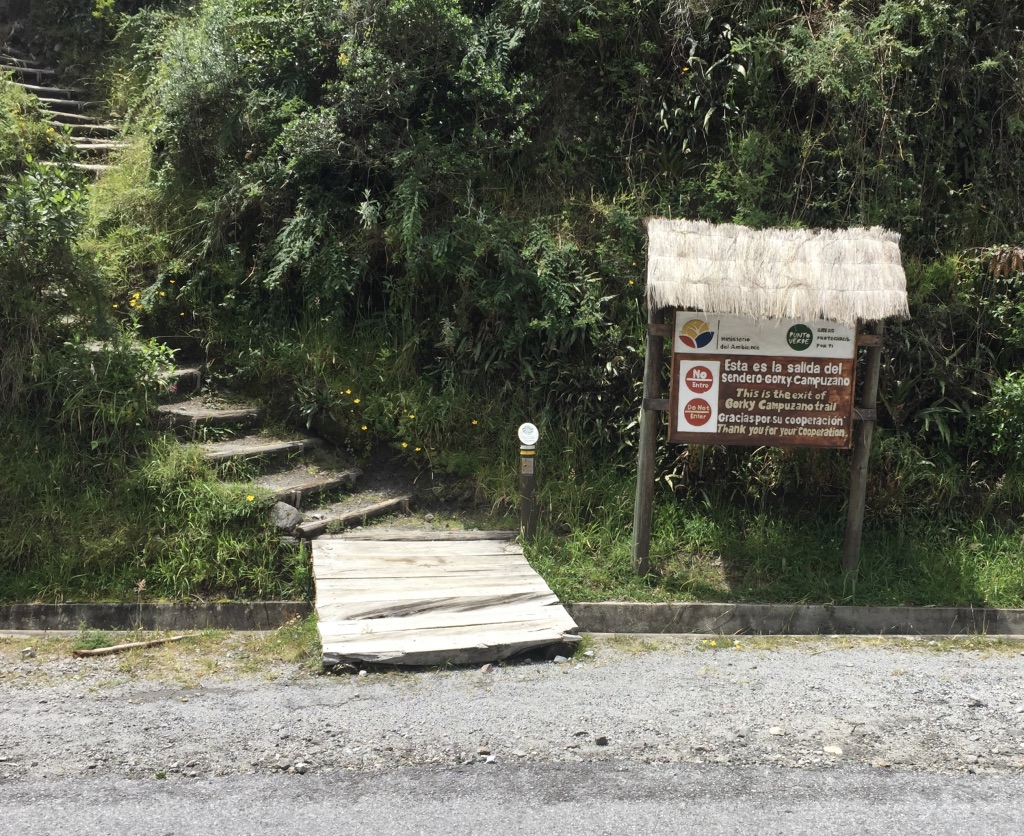
Both routes are OK. There isn’t much difference between the two, I think. Maybe the counterclockwise route is just a little bit harder in the beginning, when the legs need to get warm and you have to find your rhythm. If you, like me, make the round regularly, it’s nice to have alternatives!
Make your round …around Cuicocha: the Long tour
Head to the right side of the Visitors center and take the stairs.
The whole path around the lake is 14km/ 8.5 miles long. This route or path/sendero is called Las Orquídeas/ The Orchids and takes you around the lake in about 4 to 5 hours. When it comes to altitude, you’ll go up & down between 3100m and 3500m (10000ft -11500 ft).
The path follows the crater rim almost permanently, giving you spectacular views of the lake.
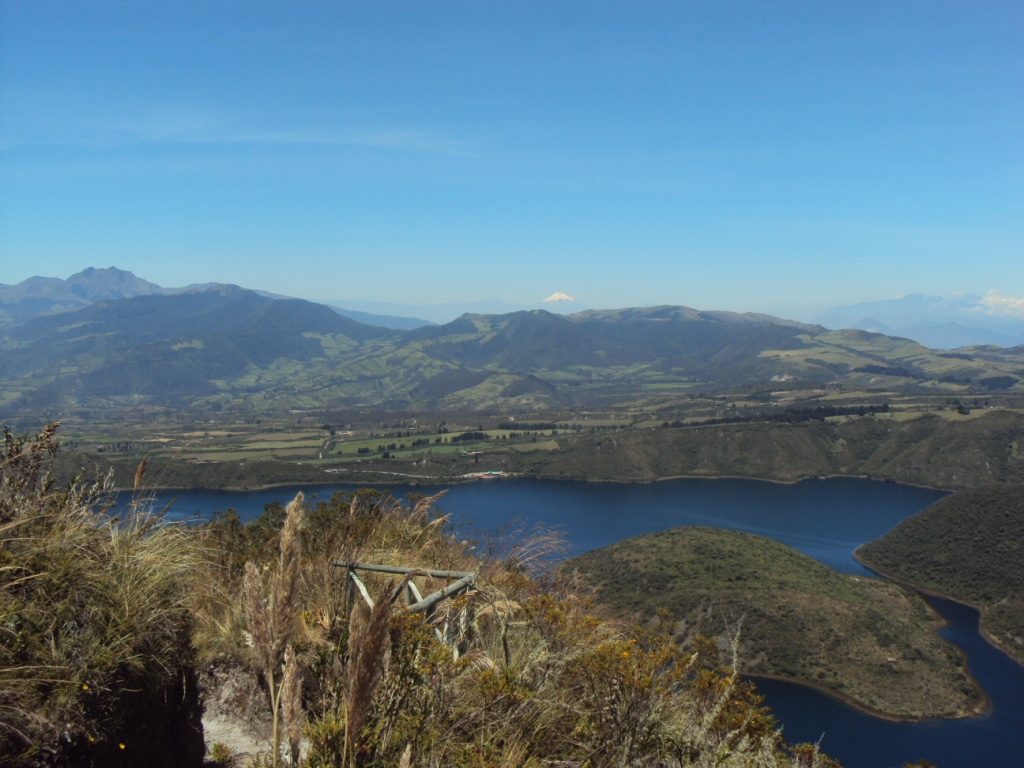
While making your round you’ll get a lot of surprises. Even in a relatively small natural habitat as the Cuicocha lake area, the diversity in vegetation is enormous.
A few years ago, you could only circle the lake partially (about 80%). The main reason was a hotel that had taken possession of the path. Therefore, every hiker was obliged to leave the rim and continue on the main road that runs between the town of Cotacachi and the canton of Intag. Nowadays however you can make the whole round. Much better!
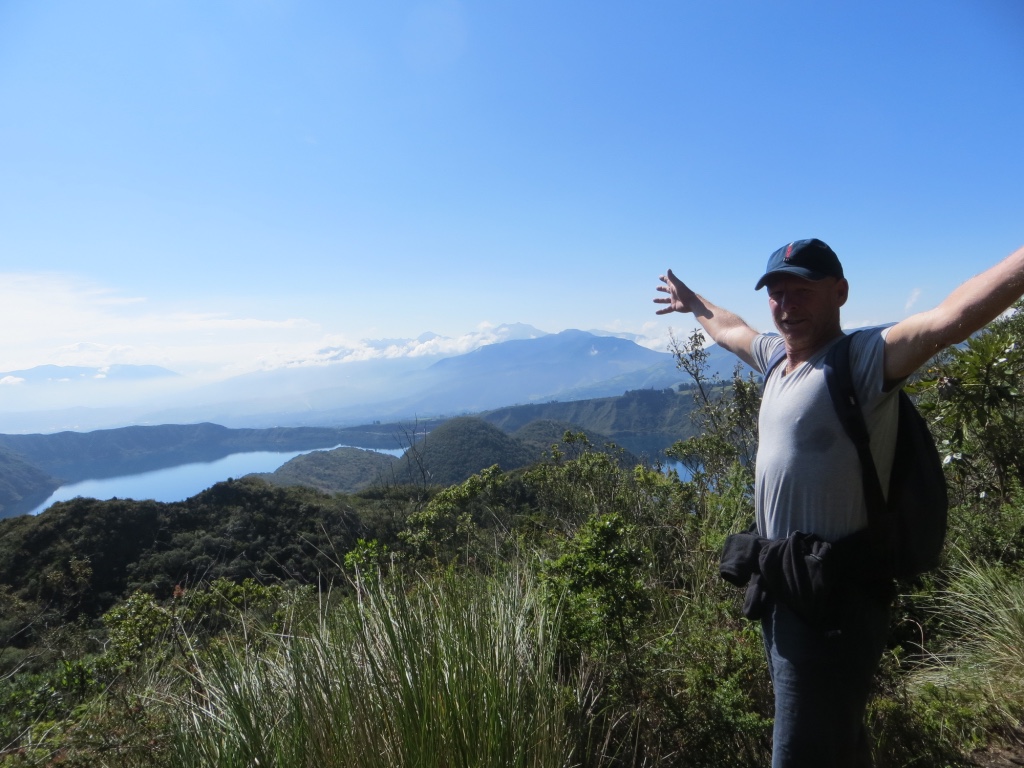
Make your round …around Cuicocha: the Short tour
I visited the Cuicocha lake many times. In all, I rounded the lake maybe 10 times, but on most visits I just enjoyed a short tour of the lake. Generally it was sunny, but even when it was cloudy or rainy I enjoyed the hike tremendously.
In addition, if not in for a long nor short walk you can always find a nice spot to just sit down and enjoy the views or have a picnic.
If you decide for a short tour though, there are many alternatives. You can take one that’s indicated on the maps you’ll find at the Visitors center or along the trails. But besides that you can – of course! – always decide for yourself how far you take a certain path & turn back whenever you like.
The Sacred route
There’s only one official short route I will mention here. Mainly because a lot of people and tour groups take that one. It’s called the Ruta Sagrada/The Sacred route and takes between 30 and 45 minutes.
This path, as well as that of the long tour, starts at the stairs at the right side of the Visitors center.
This short tour not only provides you with a good idea of the unique Flora & Fauna of the lake area, but will also give you great views of the lake & its surrounding area.
On this tour you can almost always see Otavalo in the distance. As well as Mt. Imbabura (4621m/ 15161ft) & the Mojando lake area, with the characteristically doble summit of the Fuya Fuya volcano & Cerro Negro. And if you’re really lucky you can even spot the Mt. Cayambe (5790m/ 19347ft).
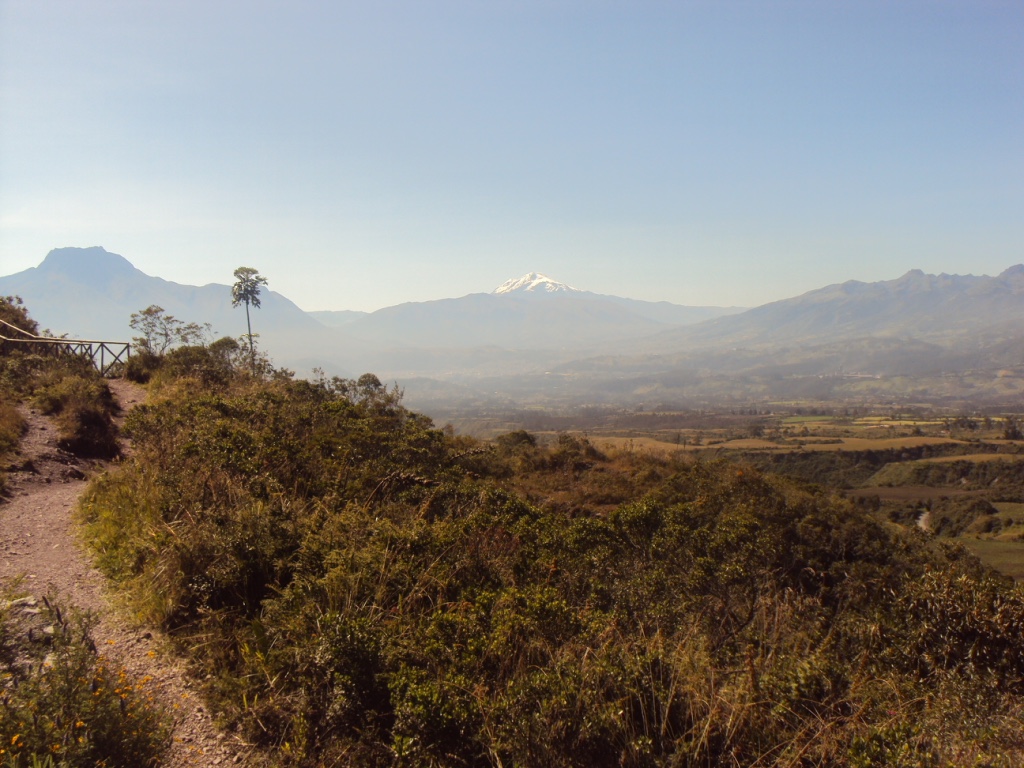
On this special short tour you’ll also pass some recently renovated indigenous-cultural spots. Like a solar and a lunar calendar, as well as a place for offerings & a ritual bath. For most indigenous people the mountains, lakes and waterfalls are Holy places where they periodically gather to ask their Gods for protection.
Visit Cuicocha on the weekends
On the weekends there are small boats (up to 20 people) that for a few dollars take you on a short tour of the lake (30-40 minutes).
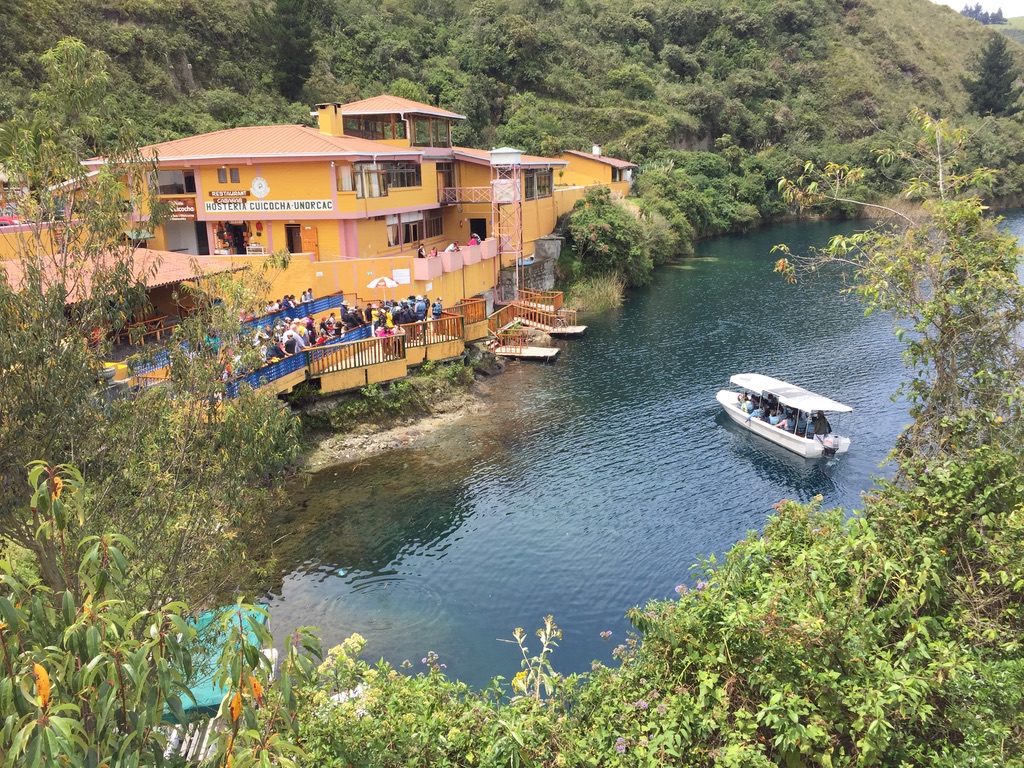
The boat tour takes you around the two islands or sometimes through the small channel between them. This channel is called the Canal de los Ensueños, which translates as Dream Channel. Or maybe better, the Dreamy Channel.
Many years ago it was possible to visit the bigger island. However, soon a fire broke out and devastated a big chunk of it. Luckily nature has taken over again, but you can still see the consequences. Some constructions on the island survived, as well as a little chapel (that you can spot even from the shore).
Although you can’t visit the islands themselves, every boat makes a short stop on the far side of the islands. There’s where your guide will give you some background information about the lake & islands (mostly in Spanish).
Because you find yourself on a spot that’s permanently monitored for volcanic activity, the guide – as proof – will indicate where you can spot little gas bubbles coming up from the bottom of the lake (the deepest point of the lake being 200m/ 656 ft below)
- Important note: The boat ticket includes a drink afterwards, a so-called Canelazo. A typical drink from the Ecuadorian highlands – cinnamon tea with a shot of local brewed alcohol. A famous beverage we also offer every guest that comes for dinner to our restaurant Árbol de Montalvo in the center of Otavalo.
Tips & recommendations for your visit to the Cuicocha lake
- Start early! I would say between 8-9 am. The best moment to hike in the Ecuadorian Andes is in the morning. Generally, in the afternoon clouds come rolling in.
- Follow the paths. The paths are well indicated, so you won’t lose yourself. In certain parts, where it gets a little steeper, the park authorities constructed stairs.
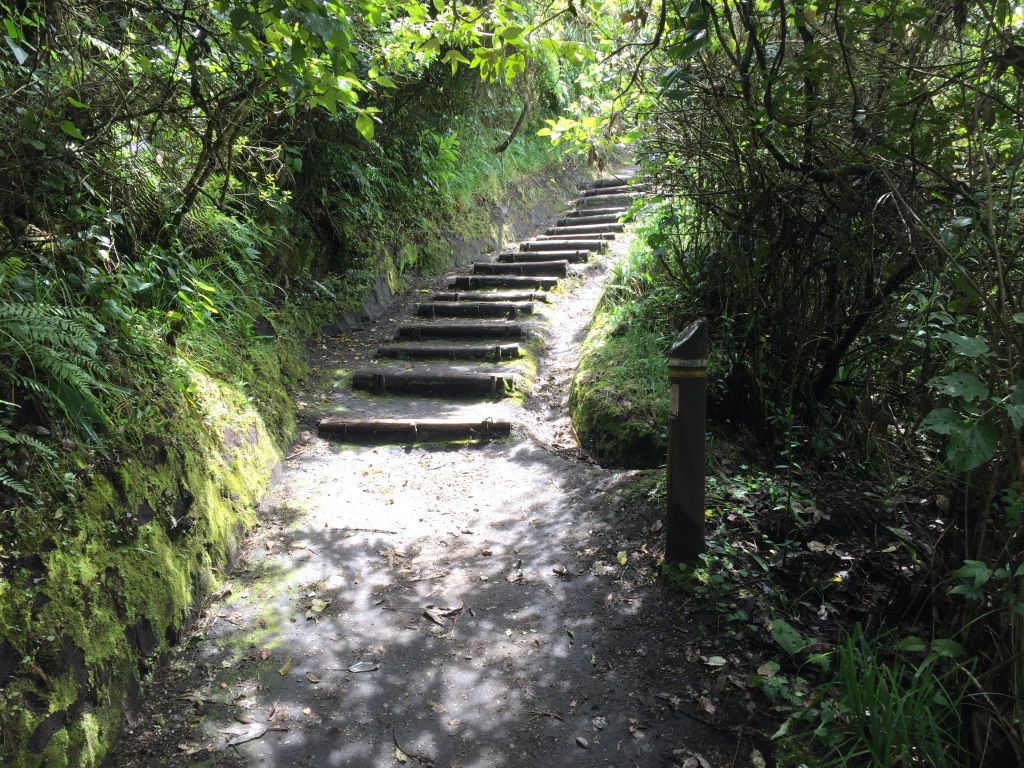
- Bring your own food & drink. During weekdays there’s not much for sale at the lake. On the weekends you can buy something at the cafeteria or even have a bite in one of the restaurants. It’s better and cheaper though to get your provisions elsewhere.
- On the far side of the lake there are two palapas (“open-sided dwellings with a thatched roof”). Because you’re halfway, that may be a good spot to have a break. But of course, depending on the weather you can have a rest & a bite anywhere.
- Quite a few people visit Cuicocha with a guide. However, it’s easy to make the round on your own. Still, if you want one, guides are available in Otavalo. If interested, we can arrange one for you at our hotel.
- Be prepared for every type of weather: cold, warm, sunny, rainy. Sometimes it even can hail or snow.
- Protect yourself from the sun (at least Protector 50).
- One of the best tips I can give you is a visit to the museum at the Visitors center of the Cuicocha lake. It’s a small museum, but it gives you a good idea of the place you are visiting. Location, geography, flora & fauna, the way people used to live in the area, et cetera. (Since the pandemic it only opens in the weekends)
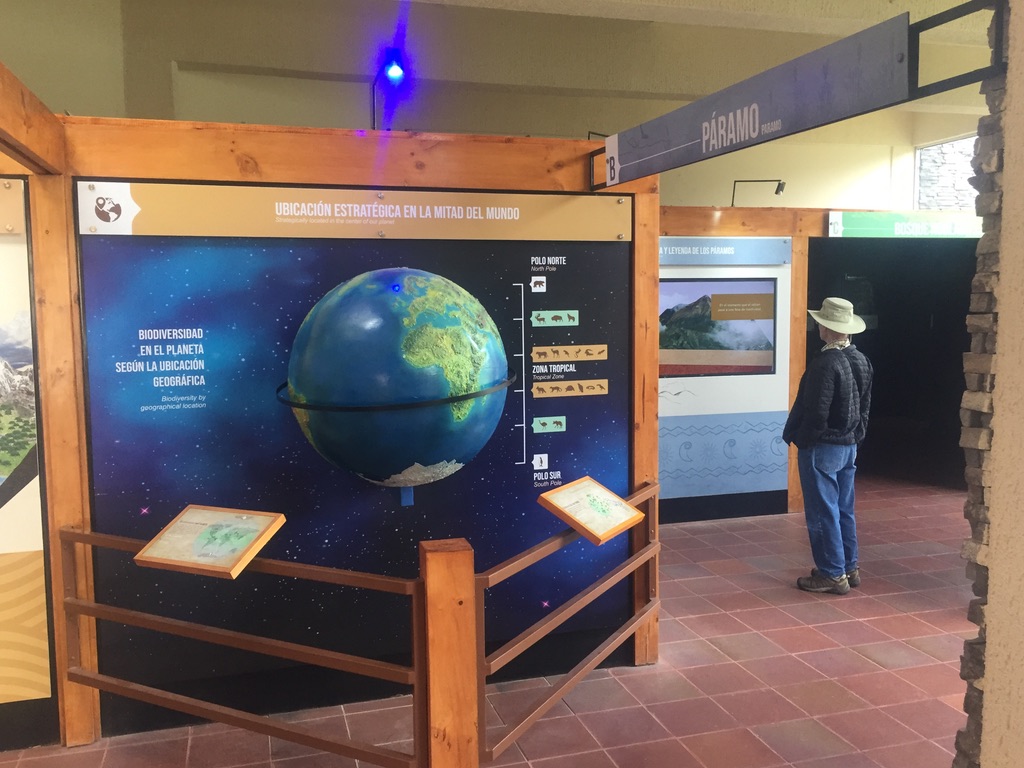
Cuicocha: How to get to there
The best way to get to the Cuicocha lake is by taxi or pick-up. You can find them all over Otavalo.
- I would recommend you to negotiate a price beforehand & pay at the end of the tour.
- And secondly, be sure he – or sometimes she – knows how to drive. (Hard to know beforehand, but I’d say hire a somewhat older driver – not the young guys – and if you don’t like the way he/she drives soon enough, look for another one).
Alternatively we – at Hotel Doña Esther/Restaurante Árbol de Montalvo – can arrange a taxi for you. For a good price & driven by a friendly, trustworthy & professional driver.
- IMPORTANT: We can only provide this service to guests of our hotel.

- Entrance to the Cuicocha lake is free. However you have to inscribe your name, nationality & passport number at the gate (Note: Bring your passport, or better a copy. Something I would recommend you to do everywhere in Ecuador.)
- There are Park rangers at the entrance, but seldom in other parts.
* If you like we can prepare a take-away box lunch ($6.00 each) for you at the hotel.
What else to do in the area
- If starting & finishing early, you still have the afternoon to do other things. Many visitors combine a trip to the Cuicocha lake with a visit to the little town of Cotacachi nearby (only a 15 minute drive from the lake, partially on the way back to Otavalo, which is another 15-20 minutes further on).
- Cotacachi is mostly known for its leather works. As in Otavalo there’s a big assortment of products, for everybody’s taste & price range. Many of the articles are handmade, not always produced in Cotacachi itself, but beautiful anyway.
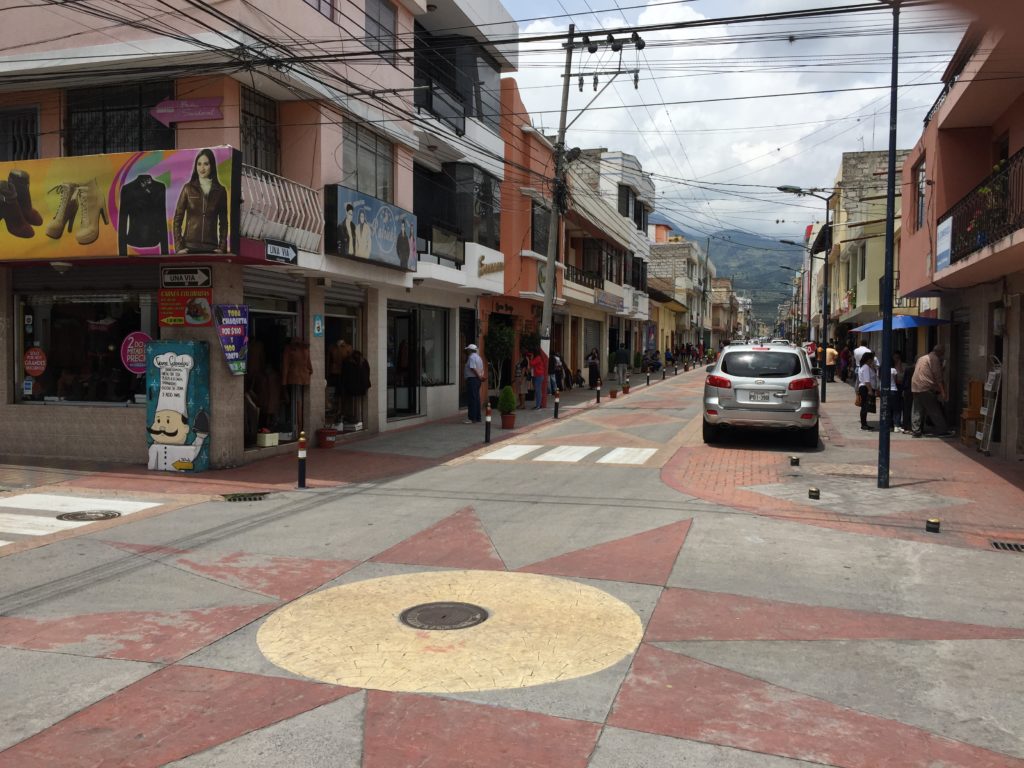
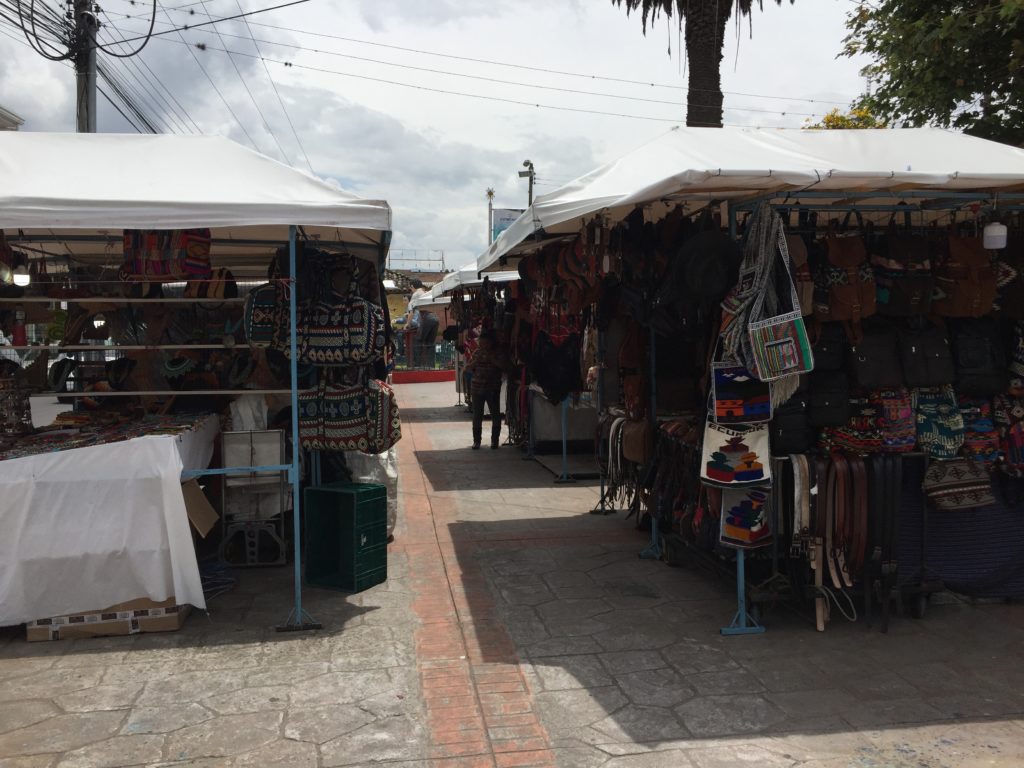
- Other tourists plan only a short visit to Cuicocha and include it in a wider tour of the province. Besides Cuicocha & Cotacachi they plan a tour including a visit to the Peguche Waterfall, the Condor Park, the weavers or hat makers at their own workshop & other things to do in the province of Imbabura.
So, as a conclusion, when you visit Otavalo the Cuicocha lake is a MUST SEE. And easy to combine with visits to other Things to do nearby.
Contact us:
Just write to us with your questions & wishes, and we’ll help you out:
Alternatively, for more information or a reservation in our hotel and/or restaurant, you can use the Whatsapp Button below:
- For extra general info about Ecuador, please join my Visit Ecuador Facebook Group.
*****
.
For other Things to do in & around Otavalo, go to: Otavalo Attractions
For an overview of all travel posts of my blog, go to: the Home Page.
